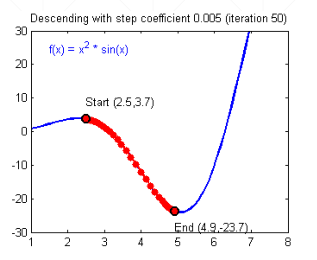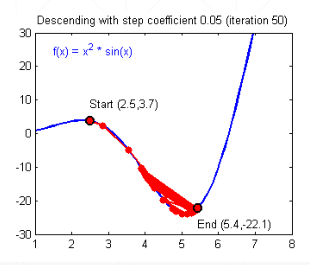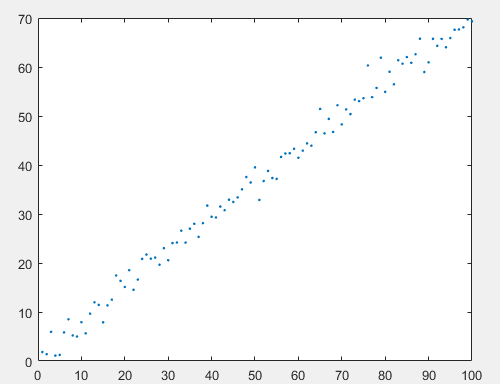回归——线性回归模型复现
问题重述
现在有一个二维空间中的点集
[
x
i
,
y
i
]
[x_i,y_i]
[xi,yi],需要使用如下线性模型拟合:
y
=
w
∗
x
+
b
y=w*x+b
y=w∗x+b
要求拟合误差尽可能小。对于所有的点
(
x
i
,
y
i
)
(x_i,y_i)
(xi,yi),误差用如下函数衡量:
l
o
s
s
=
∑
(
y
i
−
(
w
∗
x
i
+
b
)
)
2
loss=\sum(y_i-(w*x_i+b))^2
loss=∑(yi−(w∗xi+b))2
其中:
- w ∗ x i + b w*x_i+b w∗xi+b表示预测的值
- y i y_i yi表示真实的值
- y i − ( w ∗ x i + b ) y_i-(w*x_i+b) yi−(w∗xi+b)表示预测值与真实值的偏差,取平方使得每一项都为正数
- 最后将每一组$ (x_i,y_i)$的偏差求和即为总的偏差值
求解思路——梯度下降法
求解的目标是通过改变 w w w和 b b b,使得对于点集 [ x i , y i ] [x_i,y_i] [xi,yi]计算出的 l o s s loss loss函数的值最小。
根据导数的含义,我们知道 ∂ l o s s ∂ w \frac{\partial{loss}}{\partial{w}} ∂w∂loss表示当前状态下 w w w微小的变化造成的 l o s s loss loss变化量的多少,同理, ∂ l o s s ∂ b \frac{\partial{loss}}{\partial{b}} ∂b∂loss表示当前状态下 b b b微小的变化造成的 l o s s loss loss变化量的多少,而 ( ∂ l o s s ∂ w , ∂ l o s s ∂ b ) (\frac{\partial{loss}}{\partial{w}},\frac{\partial{loss}}{\partial{b}}) (∂w∂loss,∂b∂loss)为函数 l o s s loss loss的梯度, l o s s loss loss函数延负梯度方向下降最快
经过计算,我们可以得到:
∂
l
o
s
s
∂
w
=
∑
2
∗
x
i
∗
(
y
i
−
(
w
∗
x
i
+
b
)
)
∂
l
o
s
s
∂
b
=
∑
2
∗
(
y
i
−
(
w
∗
x
i
+
b
)
)
\frac{\partial{loss}}{\partial{w}}=\sum2*x_i*(y_i-(w*x_i+b))\\ \frac{\partial{loss}}{\partial{b}}=\sum2*(y_i-(w*x_i+b))
∂w∂loss=∑2∗xi∗(yi−(w∗xi+b))∂b∂loss=∑2∗(yi−(w∗xi+b))
于是,我们可以沿着负梯度方向,通过如下公式不断更新
w
w
w和
b
b
b,使得
l
o
s
s
loss
loss以最快的速度不断减小直至局部最小值:
w
n
e
w
=
w
o
l
d
−
α
∗
∂
l
o
s
s
∂
w
=
w
o
l
d
−
α
∗
∑
2
∗
x
i
∗
(
y
i
−
(
w
∗
x
i
+
b
)
)
b
n
e
w
=
b
o
l
d
−
α
∗
∂
l
o
s
s
∂
b
=
b
o
l
d
−
α
∗
∑
2
∗
(
y
i
−
(
w
∗
x
i
+
b
)
)
w_{new}=w_{old}-\alpha*\frac{\partial{loss}}{\partial{w}}=w_{old}-\alpha*\sum2*x_i*(y_i-(w*x_i+b))\\ b_{new}=b_{old}-\alpha*\frac{\partial{loss}}{\partial{b}}=b_{old}-\alpha*\sum2*(y_i-(w*x_i+b))
wnew=wold−α∗∂w∂loss=wold−α∗∑2∗xi∗(yi−(w∗xi+b))bnew=bold−α∗∂b∂loss=bold−α∗∑2∗(yi−(w∗xi+b))
其中
α
\alpha
α称为学习率(learningRate),也就是沿负梯度方向每一次前进的“步伐长度”,如果
α
\alpha
α选择太小将会导致下降速度过慢,需要迭代多次才能到达局部最小值点。如果
α
\alpha
α选择过大将会导致步伐过大错过了局部最小值点,从而在最小值点附近震荡。
注意:
-
如果步伐足够小,则在不断逼近最小值点的过程中,每一次计算出的 ∂ l o s s ∂ w \frac{\partial{loss}}{\partial{w}} ∂w∂loss和 ∂ l o s s ∂ b \frac{\partial{loss}}{\partial{b}} ∂b∂loss都会不断减小,从而即使不用调整 α \alpha α每次移动步伐也会不断减小,最终收敛到局部最小值点

-
如果步伐过大导致剧烈的震荡,每一次计算出的 ∂ l o s s ∂ w \frac{\partial{loss}}{\partial{w}} ∂w∂loss和 ∂ l o s s ∂ b \frac{\partial{loss}}{\partial{b}} ∂b∂loss都会增大,从而导致步伐进一步增大,震荡幅度不断增大。这是一个正反馈,最终导致 l o s s loss loss达到无穷大

模型复现
数据的生成
使用软件:matlab
首先在matlab中使用 y = 0.7 ∗ x + 1.22 + e r r y=0.7*x+1.22+err y=0.7∗x+1.22+err生成100个点的数据,其中 e r r err err为一个服从正态分布 N ( 0 , 2 ) N(0,2) N(0,2)的随机抖动。得到的点如下图所示:
之后将点的数据写入excel表格中
模型求解
编译环境:Pytorch3.7
语言:python
代码:
#coding=utf-8
import numpy as np
import xlrd
#读取excel文件的内容
class excel_read:
def __init__(self, excel_path=r'data2.xlsx', encoding='utf-8', index=0):
self.data = xlrd.open_workbook(excel_path) ##获取文本对象
self.table = self.data.sheets()[index] ###根据index获取某个sheet
self.rows = self.table.nrows ##3获取当前sheet页面的总行数,把每一行数据作为list放到 list
def get_data(self):
result = []
for i in range(self.rows):
col = self.table.row_values(i) ##获取每一列数据
#print(col)
result.append(col)
#print(result)
return result
#计算loss
def compute_error_for_line_given_points(b, w, points):
totalError = 0
for i in range(0, len(points)):
x = points[i, 0]
y = points[i, 1]
totalError += (y - (w * x + b)) ** 2
return totalError / float(len(points))
#延负梯度方向更新b和w
def step_gradient(b_current, w_current, points, learningRate):
b_gradient = 0
w_gradient = 0
N = float(len(points))
for i in range(0, len(points)):
x = points[i, 0]
y = points[i, 1]
b_gradient += -(2 / N) * (y - ((w_current * x) + b_current))
w_gradient += -(2 / N) * x * (y - ((w_current * x) + b_current))
new_b = b_current - (learningRate * b_gradient)
new_w = w_current - (learningRate * w_gradient)
return [new_b, new_w]
#不断进行迭代
def gradient_descent_runner(points, starting_b, starting_w, learningRate, num_iterations):
b = starting_b
w = starting_w
for i in range(num_iterations):
b, w = step_gradient(b, w, np.array(points), learningRate)
return [b, w]
#主程序
def run():
#初始化
points = np.array(excel_read().get_data())
learningRate = 0.00005
initial_b = 0
initial_w = 0
num_iterations = 100000
#输出初始条件
print("Starting at b={0},w={1},error={2}".format(initial_b, initial_w,
compute_error_for_line_given_points(initial_b, initial_w, points)))
#计算、迭代
print("Running")
[b, w] = gradient_descent_runner(points, initial_b, initial_w, learningRate, num_iterations)
#输出结果
print("End at b={0},w={1},error={2} after {3} turns".format(b, w, compute_error_for_line_given_points(b,w, points),num_iterations))
if __name__ == '__main__':
run()
























 5136
5136











 被折叠的 条评论
为什么被折叠?
被折叠的 条评论
为什么被折叠?








